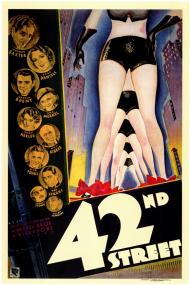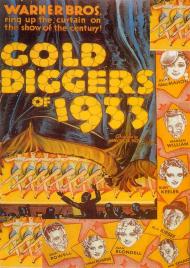Movie Review
Dancing Lady
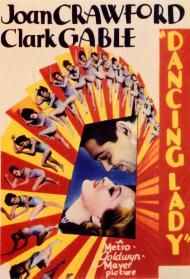
US Release Date: 11-24-1933
Directed by: Robert Z. Leonard
Starring▸▾
- Joan Crawford, as
- Janie Barlow
- Clark Gable, as
- Patch Gallagher
- Franchot Tone, as
- Tod Newton
- May Robson, as
- Dolly Todhunter
- Winnie Lightner, as
- Rosette LaRue
- Ted Healy, as
- Steve
- Fred Astaire, as
- Himself
- Robert Benchley, as
- Ward King
- Nelson Eddy, as
- Specialty Singer
- Sterling Holloway, as
- Pinky
- Moe Howard, as
- Moe - Stagehand
- Curly Howard, as
- Curly - Stagehand
- Larry Fine, as
- Harry - Pianist
- Eve Arden as
- Marcia - the Southern Actress
![2.5 star[s] out of 4](http://www.threemoviebuffs.com/static/images/global/featured_gold_stars.png)
![2 star[s] out of 4](http://www.threemoviebuffs.com/static/images/global/featured_gold_stars.png)
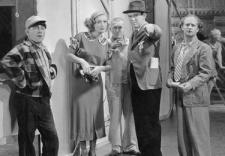
Joan Crawford and Ted Healy with Moe, Curly and Larry.
Dancing Lady is a purely paint by numbers 1930s musical. A girl wanting to make it big on Broadway was the common excuse of the decade to put a song and dance routine into a movie. Just look at all of those Broadway Melody films. What makes this particular movie memorable though is the cast.
Screen veteran Crawford, stars as a dancer working in a burlesque review. Her strip tease gets the attention of a rich guy, Tone. Noticing how he is staring at Crawford, a girl with him says, "The judge will give you 15 years for what you're thinking." He responds, "It'd be worth it." He wants to bang her like there is no tomorrow, and will go to any length to make it happen, even though she warns him, "Sorry to tell ya, but I'm the kind of investment that doesn't pay." He helps her get in a Broadway show, and then has it cancelled when she decides to spend more time on it than him. She has meanwhile fallen for the play's director, Gable in one of his first mustache roles.
Dancing Lady is the film debut of Fred Astaire. He plays a member of the play's cast and only appears in a couple of scenes to dance with Crawford. For some reason they never even created a character's name for him. Gable just calls him Freddy Astaire. This was also the first film for crooner Nelson Eddie, whose role is to stand off to the side and sing, while Crawford dances.
Also in the cast are the Three Stooges. At this point in their career, they were known as Ted Healy's stooges. They were a novelty act. The DVD even includes a short film of theirs with Ted Healy. They would soon stop appearing in feature films, and begin starring in their very own shorts and as they say, the rest is history.
Dancing Lady contains some elaborate musical numbers that could never fit on a real Broadway stage. One piece involves people walking under an arch on the stage and coming out the other side in different clothes. The horse drawn carriage comes out the other side as a car. Then there is a gigantic merry-go-round with pretty girls riding it for no apparent reason other than for the director to showcase them.
Although not a great movie, Dancing Lady is a must for film buffs of the 1930s.
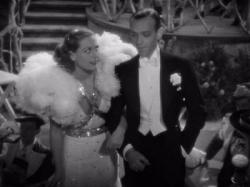
Joan Crawford provides Fred Astaire with his first screen dance partner in Dancing Lady.
Clearly MGM wanted to get in on the money that Warner Bros. was raking in with their string of backstage musicals like 42nd Street and Gold Diggers of 1933. This one follows a familiar formula. A young unknown dancer yearns for her big break while fending off the advances of a Park Avenue swell. After much predictable happenings the movie ends with a big musical number that could never take place on an actual stage. All that was missing was the genius of Busby Berkeley.
Crawford is the star around which the mostly male cast revolves. Although she would later marry Franchot Tone she has much better chemistry with Gable. They sizzle when on screen together which is why they paired up for a total of 8 pictures. Robert Benchley plays a witty gossip columnist (what a stretch) and as Eric mentioned both Fred Astaire and Nelson Eddy appear, before they would each become half of the most successful dancing and singing teams, respectively, of the 1930’s. The 3 stooges do a bit of their trademark slapping and nyucking.
Although Crawford dominates the screen, a few other women manage to make an impression. May Robson steals a scene or two as Tone’s hard of hearing grandmother and a young Eve Arden has a cameo as a Southern actress. Winnie Lightner is good as the wisecracking best friend. My favorite bit of dialogue occurs between 2 chorus girls when Gable announces the show will be closing. One says, “My parents never wanted me to become an actress.” The other replies, “They needn’t worry. You didn’t.”
The costumes and sets look expensive. Adrian draped Crawford’s sleek figure in a few dazzling gowns and there is a scene where Crawford and Tone go swimming in what could only be a movie set from the 1930’s. Dancing Lady contains that famous MGM gloss and it provides the answer to the trivia question: Who was Fred Astaire’s first screen dance partner? If only the script had an original idea in it because with this cast this should have been a classic instead of merely a curiosity.
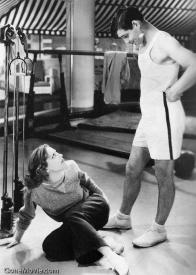
Joan Crawford and Clark Gable in Dancing Lady.
Dancing Lady does feel like a bit of a cliche and is very much of its time. The backstage musical was a genre unto itself in the early 1930s. This MGM production is slick and polished, but is a little more heavy than the Warner Bros.'s productions, even with the presence of the Stooges. It also lacks the spectacle of Busby Berkeley and the finale is definitely lacking despite the presence of Astaire and Eddy.
The best thing this movie has going for it is the pairing of Gable and Crawford. She would marry co-star Franchot Tone two years after this movie, but it is with Gable that she shares the real chemistry. They have a spark together that brings the movie alive. Their scene in the gym together is the best one in the whole movie and watching it makes it easy to believe the stories that the two stars conducted a long extramarital affair.
Certain elements of the story make it plain that this is a pre-code film. Crawford begins the movie working in a Burlesque show. Her first number is a striptease and while she doesn't get nude, her and the other girls do strip down to some fairly skimpy outfits for the time. You can also see her nipples through her dresses in several scenes, which is something you never see once the code went into effect. And her bathing suit molds itself to her body in the swimming scene and it's plain to see that Joan Crawford had a very nice bottom from all that dancing. Eric, you've mentioned how men in older movies were never allowed to be horny, but Franchot Tone's character is a regular horndog. He gets to lust after Crawford for the entire film and who can blame him.
The final dance numbers are silly and as both of you said completely implausible as stage numbers, but as this was so common in those types of musicals you just have to ignore it. More bothersome is that even with all the editing and filming tricks the numbers still aren't all that interesting or fun. And the songs are all forgettable.
I agree Eric that this isn't a great movie, but I thought it was a pretty damn good one despite the cliches.
Photos © Copyright Metro-Goldwyn-Mayer (MGM) (1933)

